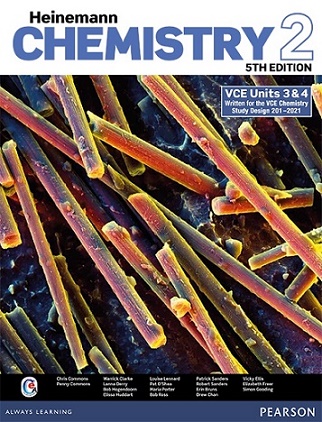Title: Heinemann chemistry 2 | Author(s): Chris Commons | Publisher: Pearson | Year: 2017 | Edition: 5th | Language: English | Pages : 674 | Size: 91 MB | Extension: pdf
This Combo Pack contains the Student Book and access to Reader+ for Heinemann Chemistry 2, 5th Edition.
Reader+ gives you access to the eBook version of your Student Book as well as bonus multimedia assets. It’s built to work online and offline, making content easily available anytime, anywhere, in every school. It works on PC and Mac, Android and iOS.
Learners can quickly navigate through their eBooks, read them, take notes and save bookmarks. Reader+ integrates multimedia (audio/video) and interactive activities that enhance and extend the reading experience.
**Note: when you order any Student Book that includes access to the eBook, the access code may be referred to as "eBook 3.0" instead of Reader+. If you activate this code now you will receive access to eBook 3.0 for the remainder of 2017. From January 2018 your account will be switched over to the corresponding Reader+ product.
The market-leading and well known Heinemann Chemistry has been updated to fully match the 2016-2020 VCE Chemistry Study Design. Weve vastly improved this series while still retaining the style and approach that teachers love.
- Unit 3: How can chemical processes be designed to optimise efficiency?
- Area of study 1: What are the options for energy production?
- Chapter 1: Fuels
- Types of fuels
- Fossil fuels and biofuels
- Petro diesel and biodiesel
- Chapter 2: Energy from fuels
- Exothermic and endothermic reactions
- Thermochemical equations and energy profile diagrams
- Energy from combustion
- Determining the heat of combustion of fuels
- Chapter 3: Combustion of fuels
- Introducing gases
- Universal gas equation
- Calculations involving combustion of fuels - Part 1
- Calculations involving combustion of fuels - Part 1
- Calculations involving energy changes
- Chapter 4: Redox reactions
- Oxidation and reduction
- Oxidation numbers
- Writing complex redox equations
- Chapter 5: Galvanic cells as a source of energy
- Galvanic cells
- The electrochemical series
- Predicting direct redox reactions
- Everyday sources of power
- Chapter 6: Fuel cells as a source of energy
- Fuel cells
- Area of study 2: How can the yield of a chemical product be optimised?
- Chapter 7: Rate of chemical reactions
- Investigating the rate of chemical reactions
- Collision theory
- Collision theory and reaction rate
- Catalysts
- Chapter 8: Equilibrium
- Dynamic equilibrium
- The equilibrium law
- Working with equilibrium constants
- Calculations involving equilibrium
- Le Chateliers principle
- Further applications of Le Chateliers principle
- Optimising the yield of industrial processes
- Chapter 9: Production of chemicals by electrolysis
- Electrolytic cells
- Commercial electrolytic cells
- Faradays laws
- Unit 4: How are organic compounds categorised, analysed and used?
- Area of Study 1: How can the diversity of carbon compounds be explained and categorised?
- Chapter 10: Structure and nomenclature of organic compounds
- Carbon compounds and structural isomers
- Stereoisomers
- The simplest hydrocarbons
- Functional groups - Part 1
- Functional groups - Part 2
- IUPAC nomenclature
- Chapter 11: Properties and reactions of organic compounds
- Boiling points and solubility of organic compounds
- Viscosity and flashpoints of organic compounds
- Chemical properties of alkanes, halo alkanes and alkenes
- Reactions of alcohols, carboxylic acids and esters
- Reaction pathways
- Yield and the chemical industry
- Chapter 12: Analysis of organic compounds using spectroscopic techniques
- Infrared spectroscopy
- Nuclear magnetic resonance spectroscopy
- Mass spectroscopy
- Determination of molecular structure using spectroscopy
- Chapter 13: Analysis of organic compounds using chromatography
- Principles of chromatography
- High performance liquid chromatography
- Chapter 14: Analysis of organic compounds using volumetric analysis
- Principles of volumetric analysis
- Acid base titrations
- Redox titrations
- Area of Study 2: What is the chemistry of food?
- Chapter 15: Structure and bonding in food molecules
- Amino acids
- The formation of proteins
- The primary and secondary structures of proteins
- The tertiary structure of proteins
- Fats and oils
- Carbohydrates
- Vitamins
- Chapter 16: Metabolism of food in the human body
- Metabolism of food in the human body
- Action of enzymes
- Enzymes - dependence of pH and temperature
- Hydrolysis of carbohydrates
- Hydrolysis of fats and oils
- Chapter 17: The energy content of food
- Food - an energy source
- Calorimetry - determining the energy content of food
- Calibration of calorimeters








